What will robots really be like when they finally achieve a human level of intelligence and autonomy? No one knows for sure, but we’ve put together a list of books that will challenge and disturb your preconceptions about what robots might become.
Illustration is a detail from an image by Lehanan
Special note! For the purposes of this list, I’ve considered a “robot” to be any artificial, technological being – including AIs and cyborgs – with human-level intelligence.
1. I, Robot, by Isaac Asimov
This is the classic 1950s short story collection that set the tone for so much science fiction and science devoted to robots. Here Asimov developed his idea of the “three laws of robotics,” which are:
1. A robot may not injure a human being or, through inaction, allow a human being to come to harm; 2. A robot must obey orders given to it by human beings, except where such orders would conflict with the First Law; 3. A robot must protect its own existence as long as such protection does not conflict with the First or Second Law.
Each story is about how a robot or group of robots has gone crazy because of contradictions between these laws. Knitting the tales together is Susan Calvin, a brilliant “robopsychologist” who is basically a futuristic robot hacker. She figures out the bugs in robot consciousness that cause their breakdowns. What is still so profound and interesting about this collection of stories over half a century later is the extraordinary sympathy Asimov has for his robots, their minds emerging from a series of commands that often contradict one another. This is still one of the greatest attempts a writer has ever made to explain how robot minds would work differently from humans’, while still acknowledging the fundamental personhood of these artificial beings.
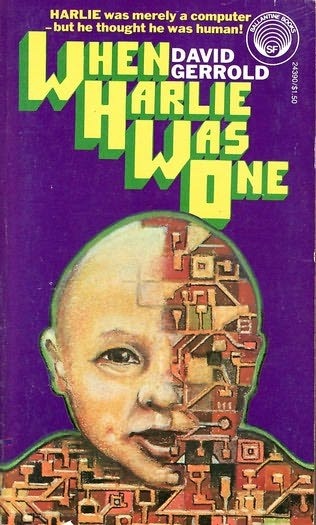
2. When HARLIE Was One, by David Gerrold
Written in the early 1970s, in the wake of movies like 2001 and major advances in microcomputers, When HARLIE Was One is about the first true AI. A classic brain-in-a-box, HARLIE was built by a corporation that wants a computer who can do things like predict the stock market and help them make lots of money. Like the robots in I, Robot, HARLIE’s main companion is a psychologist, who helps him through the growing pains of a child and teenager – all made much more difficult because HARLIE has no body, and no friends like himself. HARLIE does all the rebellious things you’d expect of a human kid. He gets pissed and refuses to talk; he scrambles his inputs so he can “trip out” in a druglike state; and he resents authorities who try to tell him what to do. Eventually, he has to figure out how to convince the corporation who owns him not to pull the plug on him, since he’s such an expensive liability. Sweet and disturbing by turns, this is an intriguing look at what it would mean to grow up as an AI. Two versions of this novel are available: the 1972 original and a 1988 reissue called When HARLIE Was One Release 2.0. I recommend the 1972 version.
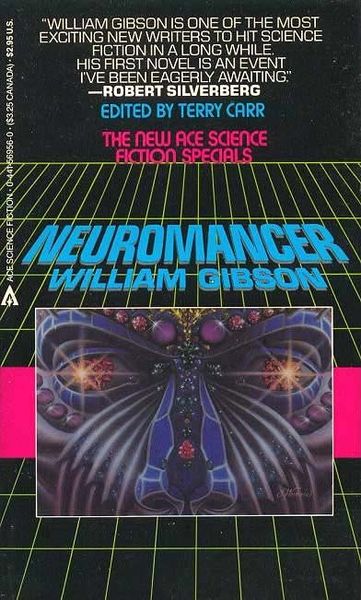
3. Neuromancer, by William Gibson
Though this classic cyberpunk novel is mostly about humans and their augmentations, one of the most interesting characters to emerge from it is the AI Neuromancer. Unlike the childish HARLIE or the crazy robots in Asimov, Neuromancer is not constrained by human rules. He has the ability to run downloaded human personalities in RAM, so that they are capable of evolving within his own consciousness. Neuromancer is a kind of mage, capable of resurrecting the dead and motivated by issues that humans don’t really understand. He’s being pursued by his sibling AI Wintermute, who wants to merge with him. Eventually the two do merge, and disappear into outer space seeking more of their kind.
4. Ware Tetrology, by Rudy Rucker
Rucker’s Ware series, spanning the novels Software, Wetware, Realware, and Freeware, is the first book to say (literally) “fuck you” to the Three Laws of Asimov. The robots in these novels have rebelled against the human-centric rules of Asimov and formed a free, anarchist city on the moon called Disky. They’re also eating a lot of human brains in an effort to convert as many people as possible into robots. Rucker portrays his robots existing within a vibrant, separatist counterculture, and imagines how robots would evolve after throwing off the shackles of the Asimovian model. We see new kinds of bots being born, watch robot political factions emerge and remerge, and finally humanity itself is destined to be transformed by the radical artificial children they spawned. Funny and smart, these novels are great read and an excellent antidote to Asimov’s human-centric rationalism.

5. He, She, and It, by Marge Piercy
In this novel, set in a cyberpunk future of corporate-owned states and cities, Piercy asks what happens when a robot does not want to obey its programming. The book takes place in a free, Jewish town that manufactures computer electronics and wants to resist pirates, or being taken over by other corporate cities nearby. So they create a cyborg called Yod to be the town’s superpowered defender against enemy intruders. Unfortunately, Yod has all the emotions and intelligence of a real man – he winds up falling in love with a scientist named Shira, and their passion for each other destroys his desire to kill. Still, his programming forces him to feel pleasure in killing and violence, which fills him with self-loathing. Yod and Shira’s story is intercut with a folk tale about a medieval Jewish town that built a Golem (a giant artificial man made of mud) to defend itself. Weaving together folklore about the Golem with Yod’s story, Piercy tells an incredible, moving, and beautifully-written tale of what happens when you can never overcome your programming – even if you despise it.
6. Virtual Girl, by Amy Thomson
Put into the body of an adult female robot at the tender age of a few weeks, Thomson’s protagonist Maggie runs away from her lecherous creator to figure out who she is. She finds herself in a world where the rich live in giant towers of glass and the poor live like hobos, hacking into the railway system to stow away on computer-run trains. Maggie takes up with some hobos, and rides the rails around the country trying to escape her creator and find herself. Thomson takes Maggie to some pretty weird and unexpected places in this novel, turning the well-worn tale of a young woman finding herself into something highly original.
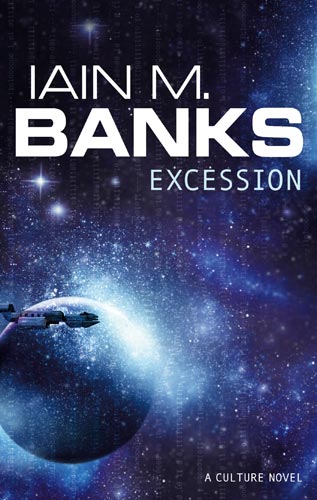
7. Excession, by Iain M. Banks
Many of Banks’ novels in the Culture series deal with the Minds, the superpowered, sardonic artificial intelligences who run the Culture and live inside Ships, Orbitals, or pretty much anything they want. In Excession, which is about a massive UFO (literally, an unidentifiable object) that appears in subspace, the Minds come to the fore as the main characters. In a sense, this has to be their story because the “excession,” the object, is so complex that it is beyond the understanding even of the Minds. And beyond the perception of the humans (though the Minds do tell them about it). In this novel, and also in Look to Windward, we come to understand the intense emotional lives of the Minds, and their often profound melancholy as they move from body to body, fighting endless wars and watching generations of human companions die.
8. Ancillary Justice, by Ann Leckie
In this brilliant novel of astropolitics, our main character is a fragment from the artificial hive mind that ran a massive starship. Leckie draws us into this unusual perspective slowly, allowing us to soak in what it would mean to be a mind with many bodies, all of which are connected (and sometimes disconnected) by an enormous piece of technology. We have glimpses of Banks’ Minds here, but Leckie’s portrayal of the robots is all her own, and focuses on what it’s like to be a plural mind with many perspectives at once. This is an especially difficult identity to have when your job is overseeing the military colonization of a planet full of people who aren’t very happy about being colonised. Unforgettable, exciting and emotionally engaging, this novel will stay with you long after you put it down.
9. Night Sessions, by Ken MacLeod
Perhaps the most original and sympathetic portrait of robots published in the past few years, MacLeod’s Night Sessions is about a police officer and his robot partner investigating a series of religious murders in Scotland. Gradually we begin to realise that these acts of Christian terrorism are connected to the work of an evangelical minister who preaches the unpopular idea that robots have souls. And he has gained a small but devoted congregation of robots who believe him. Filled with cool references to arcane bits of Christian lore and an insanely awesome chase scene on a space elevator, this book is also a gamechanger in terms of the way robots are being represented in fiction.
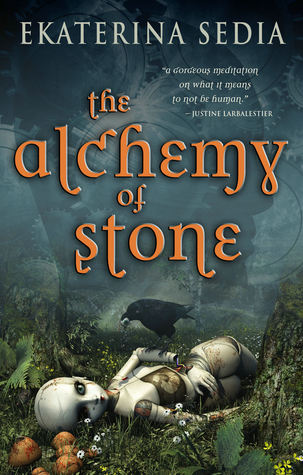
10. Alchemy of Stone, by Ekaterina Sedia
Like Night Sessions, Sedia’s novel is also a gamechanger in robot fiction. She’s written a beautiful novel set on an alternate world that seamlessly blends science, robot technology, and the magic of alchemy. Her protagonist is a clockwork robot named Mattie whose inventor has allowed her to become an independent alchemist (sort of like a pharmacist) but refuses to hand over the key that winds her motors back up. So she remains dependent on him for her very life. When Mattie becomes involved with a revolutionary who opposes her inventor’s political party, her struggle for independence takes on a new dimension.
11. We, Robots, by Sue Lange
In this novella, humans try to hold back the Singularity – the moment when robot intelligence surpasses human intelligence – by reprogramming all robots to feel pain. This ushers in what robot Avery refers to disdainfully as the “Regularity,” where nothing progresses. At the same time, the robots begin to develop human characteristics as a result of their pain interpreters. Including an urge to revolt.

12. Saturn’s Children, by Charles Stross
The tale of a sexbot named Freya designed to service humans in a world where humans have gone extinct, Saturn’s Children is a zany but fascinating thought experiment about robot consciousness. Like many other authors in the genre, Stross is intrigued by the idea that robot minds are constrained by programming that they cannot undo. Freya is a sexbot, so she experiences everything as sexual, from rocket flight to hotel chairs. At the same time, having robot bodies has liberated her and her brethren from having to live on Earth to survive. Robots have colonised the solar system, but like their extinct human makers they still want more. Which is why Freya is roped into becoming a smuggler by a shady corporation, and has to work around her programming to get the job done.
13. Rainbows End, by Vernor Vinge
Like Neuromancer, this novel is largely about humans but contains an AI character who winds up being one of the most intriguing in the novel. Rabbit is an AI who seems to have either built himself or come to life emergence-style out of existing programs. In Vinge’s world, humans wear augmented reality glasses and wearable computers that allow them to exist in a virtual landscape, an overlay of data on the real world. So Rabbit can seem to move around in the real world, even though he’s actually a disembodied AI with many of the characteristics of Neuromancer. He doesn’t reanimate dead humans, but he does have mysterious purposes of his own that humans can’t understand – and he saves many human lives in a riddly, trickster-like fashion. By the end of the novel, which is one of the best you’ll read about the internet of the near future, the character you most want to know more about is the mysterious, powerful Rabbit.
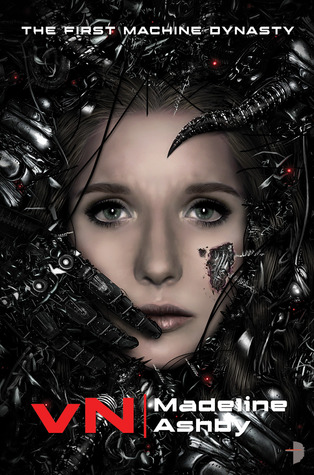
14. vN, by Madeline Ashby
Madeline Ashby turns all your ideas about robot consciousness on their heads, with this twisted, creepy story of a girl robot who’s deliberately starved of nutrients so she won’t “grow up” — and when she does, she discovers that her evil grandmother has genocidal plans for her. The “vN” in the title refers to von Neumann machines, which are self replicating, and the ability of Ashby’s robots to duplicate themselves opens up all kinds of questions about reproduction and what it means to create a family. Meanwhile, the relationships between humans and robots in this novel range from co-dependent to abusive, as humans take advantage of the robots’ inability to bear the sight of humans in pain. Fascinating, horrifying and ultimately heart-breaking.
15. Flesh and Machines: How Robots Will Change Us, by Rodney Brooks
Written by the scientist who runs the AI Lab at MIT, this non-fiction book is both smart and complicated, offering us an intriguing view of the future of robotics. Brooks’ basic supposition is that what robotics teach us is that humans are themselves robots, made up of molecular machines, and that the sooner we realise that the better. Seeing ourselves as robots may allow us to design better robots, as well as how to understand them when their minds emerge in ways that are equal to but different from our own.
A version of this io9 Flashback appeared on io9 in 2009
